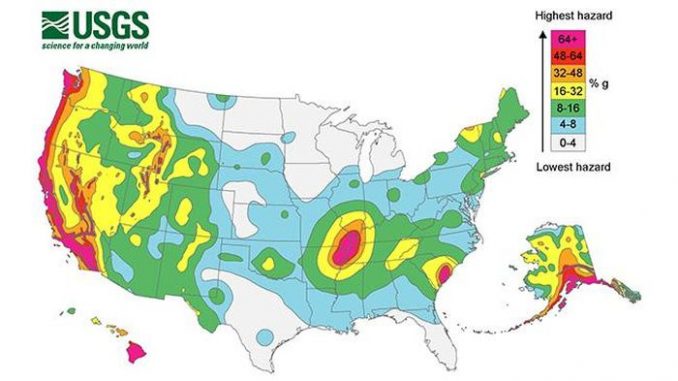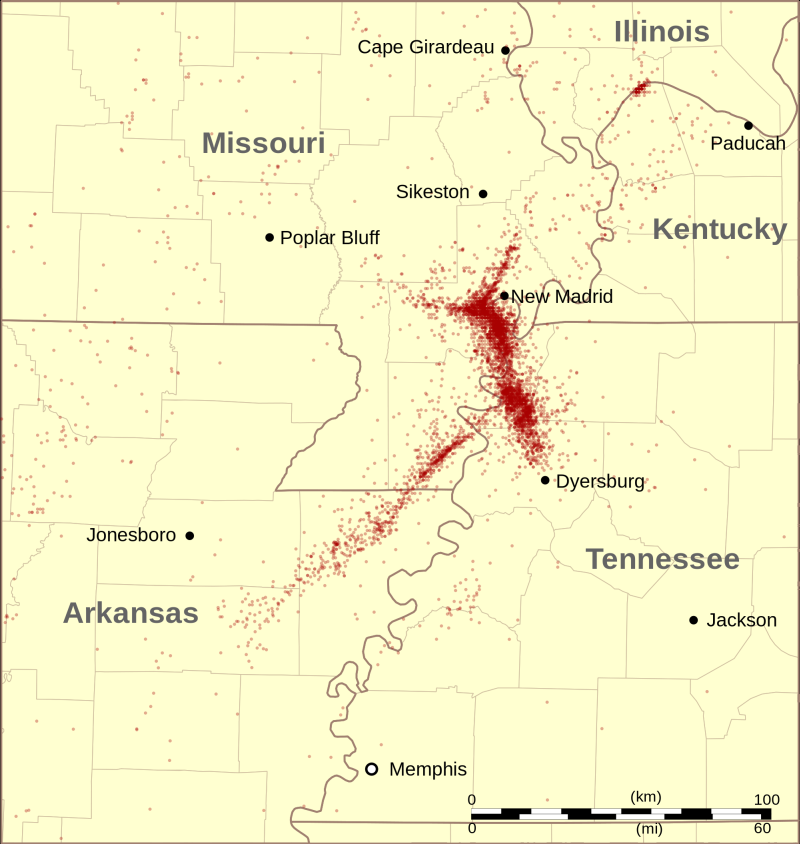
A little known fault in the Midwest could cause a mega earthquake in the center of the U.S. with devastating results.
Everyone knows that the Pacific Coast is overdue for a mega earthquake sometime soon.

BYPASS THE CENSORS
Sign up to get unfiltered news delivered straight to your inbox.
You can unsubscribe any time. By subscribing you agree to our Terms of Use
Latest Video
But not many know of the danger lurking underground in Missouri that could allow “all hell to break loose” across Middle America, according to researchers.
The Daily Mail reports:
The New Madrid Seismic Zone is 150 miles long, and experts say a quake would impact seven states – Illinois, Indiana, Missouri, Arkansas, Kentucky, Tennessee and Mississippi.
They claim ‘all hell would break loose,’ with 715,000 buildings damaged and 2.6m people left without power.
The Mid-America Earthquake Center at the University of Illinois released a report in 2009, which suggested the effects of a force seven or stronger quake from the fault line.
Amr Elnashai, the study’s lead author, wrote ‘All hell will break loose.’
The 150-mile (240 km) long fault system, which extends into five states, stretches southward from Cairo, Illinois; through Hayti, Caruthersville and New Madrid in Missouri; through Blytheville into Marked Tree in Arkansas.
It also covers a part of West Tennessee, near Reelfoot Lake, extending southeast into Dyersburg. It is southwest of the Wabash Valley Seismic Zone.
Most of the seismicity is located between 3 and 15 miles (4.8 and 24.1 km) beneath the Earth’s surface, researchers believe.
The area has not seen significant earthquakes for more than 200 years.
In the winter of 1811 and 1812 there were three earthquakes of magnitude 7 – as high as 7.7 – and a series of aftershocks across the American Midwest.
The results were catastrophic, with the course of the Mississippi being diverted, chasms ripping open, and volcanoes of sand and water bursting through the ground.
According to the Central US Earthquake Consortium (CUSEC), earthquakes in the central or eastern United States effect much larger areas than earthquakes of similar magnitude in the western United States.
For example, the San Francisco, California, earthquake of 1906 (magnitude 7.8) was felt 350 miles away in the middle of Nevada, whereas the New Madrid earthquake of December 1811 rang church bells in Boston, Massachusetts, 1,000 miles away.
Differences in geology east and west of the Rocky Mountains cause this strong contrast.
Scientists now estimate that the probability of a magnitude 6.0 or larger earthquake occurring in this seismic zone within any 50 year period is 25% to 40%, and say such an earthquake could hit the Mississippi Valley at any time.
HOW BAD COULD IT BE?The Mid-America Earthquake Center at the University of Illinois released a report in 2009, which suggested the effects of a force seven or stronger quake from the fault line. Amr Elnashai, the study's lead author, wrote 'All hell will break loose.' Nearly 715,000 buildings are damaged in the eight-state study region. About 42,000 search and rescue personnel working in 1,500 teams are required to respond to the earthquakes. Damage to critical infrastructure (essential facilities, transportation, and utility lifelines) is substantial in the 140 impacted counties near the rupture zone, including 3,500 damaged bridges and nearly 425,000 breaks and leaks to both local and interstate pipelines. Approximately 2.6 million households are without power after the earthquake. Nearly 86,000 injuries and fatalities result from damage to infrastructure. Nearly 130 hospitals are damaged and most are located in the impacted counties near the rupture zone. There is extensive damage and substantial travel delays in both Memphis, Tennessee, and St. Louis, Missouri, thus hampering search and rescue as well as evacuation. Moreover roughly 15 major bridges are unusable. Three days after the earthquake, 7.2 million people are still displaced and 2 million people seek temporary shelter. Direct economic losses for the eight states total nearly $300 billion, while indirect losses may be at least twice this amount.
James Wilkinson, director of the Central U.S. Earthquake Consortium (CUSEC), told The Atlantic the greatest threat might come from the Mississippi River newly unleashed from its engineered prison of levees.
‘The thing that, to me, makes the river scary is how much industry we have along it: there’s power plants, there’s chemical plants, there’s ports,’ he said.
‘And the river might change course altogether.’
‘So if the levees are already jeopardised either by overtopping or saturation, where the water’s been there for quite a while, and then you get a shake to it?
‘You know, the river’s just gonna take the path of least resistance. And who knows whether that’s right through these communities.
‘In a massive earthquake we could lose a good part of Western Kentucky, we could lose a good part of Arkansas or southern Missouri.’
‘The clock’s ticking.’
But not all seismologists agree.
Seth Stein, based in Evanston, Illinois, has researched the fault line for 30 years, and told The Atlantic the warnings were ‘dangerous nonsense’.
He set up GPS receivers along the fault line and found the land was moving two millimetres a year, if at all, meaning there is next to no strain within it.
In 1999, FEMA identified four hazards in the United States that, were they consummated in all their destructive wonder, would be worthy of the title ‘catastrophic.’
They were: a major earthquake hitting Los Angeles, a major hurricane hitting Miami, a major hurricane hitting New Orleans (check), and a giant earthquake hitting the Central US.



